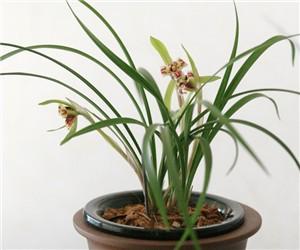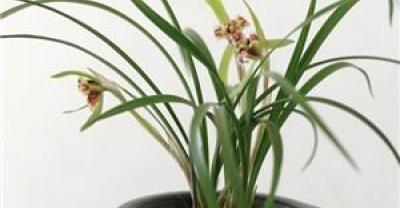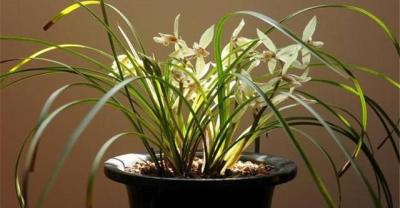How to grow orchids? Culture methods and pest control of orchids
Orchids like shade, avoid direct sunlight, like moist, avoid drying, like fertile, rich in humus, good drainage, orchids like slightly acidic sandy loam. The temperature of 15-30 ℃ is the most suitable for growth, and the growth is poor when the temperature is above 35 ℃. 5 ℃ below the temperature will affect its growth, at this time, orchids are often in the dormant form: direct sunlight will reveal leaf burns or scorch within one or two days, so there is "spring does not come out, summer is not day, autumn is not dry, winter is not wet" orchid cultivation tips, and then let us understand in detail how to raise orchids, orchid culture methods.

Varieties suitable for family maintenance
① Chunlan. The flower color of Chunlan is not gorgeous, but its fragrance is rich, the florescence is long, and it is easy to maintain. ② Huilan. Huilan leaves are moist and bright, and the flowers are delicate and fragrant. The florescence starts from the Summer Solstice's autumn. ③ Jianlan. Jianlan is adaptable and easy to cultivate, and the flowers are long and many, and the leaves are as erect as swords. ④ Cymbidium. The plant is strong, the flowers are large and colorful, the florescence is long, and it is easy to manage. ⑤ Mulan. The leaves of Cymbidium are slender and its scape is up to 60 cm high, erect on the leaves. Its petals are very beautiful with lingering brown stripes.
Pot cultivation of Orchid Culture methods
Flowerpots: planting orchids is suitable to choose mud pots with good permeability, small, high and narrow, well-ventilated, beautiful and generous as the first choice, not porcelain pots or glazed pots.
Orchids on the basin need to pay attention to what: ① choose a good permeability of the basin, such as mud basin, purple sand basin, do not use plastic basin. ② chooses acid soil with good porosity and permeability. ③ basin bottom should be covered with more broken tiles or charcoal blocks or ceramsite to facilitate drainage and ventilation. The planting depth of ④ is based on the soil surface at the end of the pseudo-bulb. ⑤ planted orchid seedlings should wait for the root system to soften before planting, there are wounds to be coated with sulfur powder to prevent germs. ⑥ on the pot, to put the seedlings in the middle of the basin, so that the root distribution is uniform, while filling the soil, while shaking the flowerpot, so that the roots and soil close. ⑦ after a good basin should be watered, placed in shelter from the wind and slightly wet place, watering frequently, until the new buds sprout, can be watered normally.
Soil selection of how to grow orchids
Orchids like fertile, rich in humus, good drainage, slightly acidic sandy loam, orchid cultivation soil, you can buy prepared orchid mud, can also be prepared by yourself.
Preparation method 1: rotten leaf soil or peat soil, sandy soil and cake fertilizer were prepared at 6:3:1.
Preparation method 2: rotten leaf soil, compost soil and coarse sand were prepared at 5:3:2.
How to water orchids
Orchids prefer a wet environment, to keep the basin soil moist, but watering should not be too much, so as not to cause rotten roots caused by stagnant water. In spring, with the rising temperature, orchids grow rapidly, at this time need a lot of water, can appropriately increase the amount of water, can be watered every 1-2 days.
High temperature in summer, large water evaporation and exuberant orchid growth can be watered in the morning and evening respectively. Never water at noon. In the rainy season, we should pay attention to the drainage of the flowerpot, so as not to accumulate too much water in the flowerpot, and watering should be carried out according to the humidity of the pot soil.
At the end of autumn, when the temperature begins to drop and the plant growth slows down, the amount of water and times of watering can be gradually reduced and can be watered every 2-3 days. The temperature is low in winter, and most orchids go into dormancy at this time, when they can be watered every 5 to 7 days to keep the soil dry and wet. However, winter flowering Cymbidium and Cold Orchid can be watered as appropriate to ensure sufficient water for their growth.
Fertilization of culture methods of orchids
To fertilize orchids, you should apply thin fertilizer, not thick fertilizer. Newly planted orchid plants can not be fertilized in the first year, and will not be fertilized until the Beginning of Autumn stops fertilizing after the Qingming Festival in the second year. During this period, fully mature thin pancake fertilizer and water can be applied once or twice a month.
For the aged orchid plants, more nitrogen fertilizer can be applied before flower bud differentiation to promote new bud germination and rapid growth. Before flower bud differentiation in autumn, liquid fertilizer dominated by phosphorus and potassium fertilizer should be applied twice successively. During the budding period, 0.2% potassium dihydrogen phosphate solution or plant ash water can be sprayed on the leaves or roots in the evening on a sunny day, which is beneficial to the healthy blooming of flowers. About 20 days after flower fade, liquid fertilizer or compound chemical fertilizer mainly based on nitrogen fertilizer was applied twice to promote plant growth.
For new and old plants, do not apply fertilizer on cloudy and rainy days, and stop fertilizing during winter dormancy. However, winter flowering cymbidium and cold orchid can apply phosphorus and potassium fertilizer as appropriate to ensure sufficient water for their growth. Stop watering 1-2 days before fertilization, and then apply it after the basin soil dries up a little. After applying fertilizer, water should be irrigated once in the morning to prevent the fertilizer solution from contaminating the orchid root and causing the orchid root to get sick. You can also wash the leaves so as not to splash the leaves with liquid fertilizer and make the leaves get sick.
Environmental requirements of Orchid Culture
Temperature: orchids require higher temperature, and the suitable temperature for growth is between 20 ℃ and 30 ℃. In winter, the temperature should be 10 ℃ ~ 20 ℃ in daytime and 0 ℃ ~ 10 ℃ in evening. Because of different varieties, their cold tolerance is also different. The lowest temperature of Cymbidium, Hanlan and Jian Cymbidium should be more than 5 ℃, and too low temperature will affect flower bud development, while Chunlan and Cymbidium require that the winter temperature is between O ℃ and 5 ℃, and too high temperature is not conducive to flower development. When the summer temperature is higher than 30 ℃, the orchid will stop growing. Therefore, it should be shaded and cooled down in summer.
Lighting: although orchids like shady environment, if they are in a shady environment for a long time, without sufficient light, it will lead to long leaves, sparse flowers, and prone to diseases and insect pests. However, if the light is too strong, it will destroy the chlorophyll in the leaves. Causing the leaves to turn yellow. What is more, it will burn the leaves, causing them to wither and die. In April, you can receive more sunlight to promote its growth. Receive six hours of sunshine a day in May, but avoid noon. In June, you can put the plant in the shade all day, or use a shading net to cover all the light.
The shaping and pruning of orchids
When pruning orchids, the scissors should be disinfected in advance. When the old leaves of orchids are found to be withered and yellow, they should be cut off in time to facilitate the ventilation of the plants. For some withered leaves at the tip, the dry parts can be cut off and cut into a bevel for beauty.
When diseased insect leaves are found, they should also be cut off in time to avoid infection. When pruning diseased leaves, the scissors can be disinfected again after cutting diseased leaves, in order to ensure safety. When the flower buds are unearthed, cut off the weak buds and leave strong buds, leaving one flower bud for each orchid seedling, in order to reduce nutrient consumption and ensure good flowering. When the flowers fade, the flowers should be cut off so as not to consume nutrients and affect flowering the following year.
Flowering management of how to grow orchids
If the flowering period of orchid is well managed, it can not only make the orchid blossom, beautiful in shape and rich in fragrance, but also lay a solid nutritional foundation for its luxuriant stems and lasting flowering in the coming year.
Generally speaking, the florescence of Chinese orchids is as long as a year. It can be said that orchids bloom every day and every month has a delicate fragrance. Spring orchids bloom, cymbidium blossoms, then four-season orchids, cold orchids blossom in winter, orchids bloom in spring, then lotus orchids and spring swords bloom in early spring. Orchids are invincible all the year round.
The Culture method of Orchid against Cold and overwintering
Winter orchid temperature content can refer to the light and temperature management section. In addition, we would like to emphasize the following points here:
Do not enter the house too early, otherwise it will be disadvantageous to the growth of the orchid, or even cause it not to blossom in the second year, and do not be too late in the room. To avoid freezing damage. During the frost, some hardy varieties that have not yet entered the house should prop up the sunshade net at night to prevent frost.
If the indoor temperature is too low, you can add a layer of plastic film, or cover the straw curtain to increase the temperature. In addition, the indoor temperature difference between day and night should not be too large, if the temperature is suddenly cold and hot, it is easy to cause orchid disease. Pay attention to the regular ventilation of orchids. But don't let it get hit by the cold wind.
When leaving the room in spring, when the lowest temperature is 20 ℃, Cymbidium can leave the room first, but it has to cover the net at night to avoid frost and snow. When Ching Ming Festival, Chunlan can go out of the room. Grain Rain, cold orchid, spring sword, lotus petal orchid can go out of the room. The Beginning of Summer when sword orchid, ink orchid can go out of the room. After the orchid comes out of the room, we should also pay attention to the weather changes. Once the temperature drops, we should move back indoors in time. Or take measures to keep warm.
Propagation methods and matters needing attention of Orchid
The main propagation of orchids mainly adopts the method of dividing plants. Generally speaking, most varieties of orchids need to split every 2-3 years, either in spring or autumn. From March to April in spring, the plant is still dormant. Ramet will not have a great effect on its growth. Autumn can be carried out in October, when the flower new roots, new buds have not yet germinated, the stem also accumulated a lot of nutrition, at this time ramet, is conducive to survival.
The moisture should be controlled two days before the ramet to ensure that the basin soil is moist, which can ensure that the orchid root is soft and can effectively reduce root damage during ramet.
Ramet should choose the strong mother plant, after selecting the mother plant, remove the soil from the basin, remove the root soil, cut off the rotten root, withered root and withered leaves on the plant. Then disinfect the root, dry it in a cool place, and so on when the root becomes white and soft, cut it with scissors in the false scale base (commonly known as "road"), then apply charcoal to the wound, and then put it back on the basin.
Control methods of Diseases and insect pests in Orchid
The main diseases and insect pests of orchids are white silk disease, anthracnose and scale insects.
White silk disease: this disease mostly occurs in the plum rain season. Should pay attention to the plant should be ventilated and transparent, basin soil drainage should be good, if found that the plant is infected, to replace the basin soil, and sprinkled with pentachloronitrobenzene powder or lime disinfection.
Anthrax: this disease is also common in hot and rainy seasons. It was found that the plant disease could be sprayed with 50% methyl topiramate wettable powder 800-1500 times.
Scale insects: in an environment with high temperature and humidity and poor air flow, this pest is the easiest to breed and can be sprayed with nutritious dimethoate or captured or scraped manually.
Prevention and treatment skills: with pig bitter bile, water in accordance with the proportion of 1RU 100 mixed, and add a small amount of washing powder, with such a solution to spray orchid plant, can prevent anthracnose. Can be mixed with liquor and water at the proportion of 1:2, spray lacquer orchid plant, spray once a week, spray 3 times, can also kill scale insects. Mix vinegar and water according to 1:8 and spray paint evenly on the front and back of the orchid leaves, which can also treat scale insects.
- Prev

Raise orchids all the year round. With one move, orchids double sprout and blossom.
Throughout the year, the rates of water absorption and evaporation of plants in orchid pots are completely different. In spring, orchids need a lot of water, but more Rain Water, orchid pots do not.
- Next

Orchid: seven planting experiences of Orchid summarized by Orchid Farmer
New florists often ask about orchids. It so happens that some flower lovers often have the opportunity to get in touch with some orchid farmers, so they often have the nerve to fight with others.
Related
- Is the orchid suitable for indoor use? Is it good for the body?
- How to prevent the empty root of orchids?
- What to do after the crab claw orchid is withered?
- Why are the leaves of orchids always yellow? Fertilizing and watering.
- Can the root of the gentleman orchid be saved if it is rotten?
- Diagnosis and treatment of cotton-blowing beetle insects in Cymbidium
- There is a way for a gentleman's orchid to rot.
- What is the most suitable temperature and humidity for the orchid?
- How to raise a gentleman's orchid? Cultivation techniques of Cymbidium
- How to prepare the nutritive soil for the cultivation of Cymbidium

